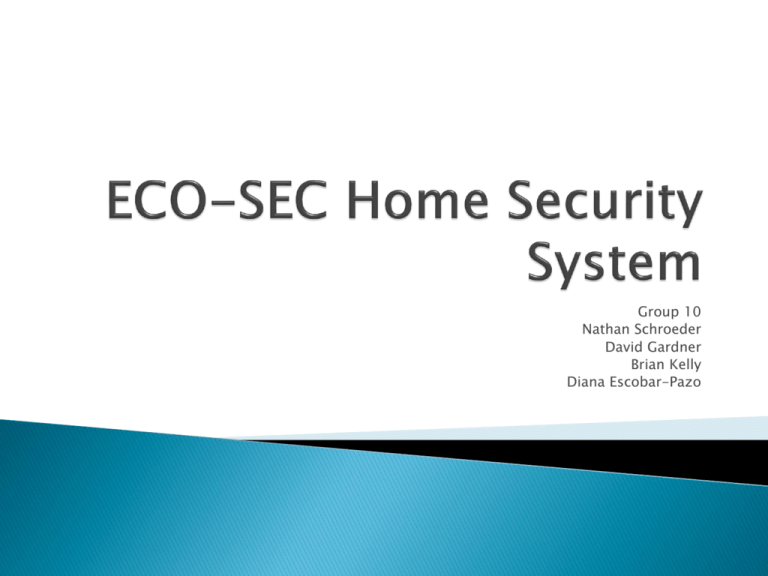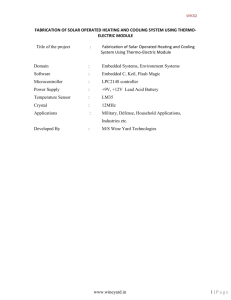ECO-SEC Home Security System
advertisement

Group 10 Nathan Schroeder David Gardner Brian Kelly Diana Escobar-Pazo Create a system to protect a user’s home from unwanted intrusions and burglaries Provide a security system that contains similar functions to professional systems but at a reduced price Create a security system that does not require additional monthly fees to a security firm Create a security system that is “green” and is as environmentally friendly as possible Ability to detect if an window or door is opened Ability to sound alarm if a window is broken Detect motion of intruders using an infrared sensor If alarm is triggered system will inform the homeowner via e-mail Will be constructed at lowest cost possible to be more economically friendly Will be powered by a series of solar panels backed up by a battery in order to produce a more “green” system Will use a camera to provide a security feed of the home that the user can view remotely using the website for the system Users will be able to control the system through a LCD touch screen or a website Infrared Sensors will cover a range of 32 ft. with a field of vision covering at least 90 degrees Sensors will be capable of detecting the breaking of a window from 15 feet away Door sensor will have a delay of 45 seconds before setting off an alarm when an intrusion is detected Solar panel will provide 30 Wh of power under 1 kW/hr solar radiation. (Efficiency of above 13%) Battery will be able to be recharged from discharged to full in 4 hours Battery will be able to provide power for up to 24 hours if sufficient sunlight for the solar panels is unavailable User communicate with the system via either the touch screen or the web server site Web server and touch screen pass information to the microprocessor when user makes a change in system operation Microprocessor will communicate with web server and touch screen in order to update status of the system Power subsystem powers all the other components of the system Sensor array informs the microprocessor when intrusion occurs Security camera sends live feed of home to the website that the user can view remotely 1. 2. 3. 4. Off – system is not powered or is deactivated Away – system is armed and all sensors are active Stay – system is armed but motion sensor is not active Alarm/Intrusion – One or more sensors have been tripped signaling an intrusion, system responds with correct alert. Can be entered using “trick code” XBee ◦ Uses 2 pins to transfer data through UART ◦ Connection through a MSP430 using I2C protocol Web Server ◦ Uses 9 pins to transfer data through RS232 (DB9) LCD Touch Screen ◦ Uses 9 pins to transfer data through RS232 (DB9) Power ◦ Uses 2 pins to transfer power into the MCU Part Selected ◦ LM3S1538 Ease of use ◦ Programming language (C, C++) ◦ Code Composer Studio Built-in options ◦ UART ◦ USB ◦ Temperature Sensor http://www.luminarymicro.com/products/products.html Hardware Testing Software Testing ◦ Alarm system must turn on upon application of power ◦ Components must communicate with the MCU ◦ Siren sounds when Burglar Mode is active ◦ Alarm Modes Use correct codes to switch between respective modes (i.e. Standby mode to Away or Stay or Burglar or Trick) ◦ Interfaces Sensors send status to the Alert Generator Microprocessor generate alerts from the generator Process alerts through the Code Accept line Let the user configure alarm features like passwords Interface MCU with the system’s touch screen Use a wall AC/DC converter for the AC power source. The switch will select one power source to use. The charge controller will efficiently charge the battery. The DC/DC converters will provide the correct voltage for all subsystems. Lithium Ion batteries are a good choice. ◦ High power density and low self discharge ◦ No memory effect ◦ Need a protection circuit Eco-Sec Average Power = 1.42Wh Distributor Voltage Power Cost Batteryspace.com 11.1 V 31.08 Wh $64.99 Onlybatteries.com 11.1 V 48.84 Wh $69.95 Onlybatteries.com 11.1 V 73.26 Wh $99.95 Batteryspace.com 57.7 Wh $103.00 11.1 V The battery can only accept 2A of charge current. Maximum power point tracking will not be used. A 30Wh to 40Wh panel balances cost and power. Product Size Power Cost UPG-30 23.13” x 11.38” 30W at 18V $94.00 UPG-40 25.59” x 21.06” 40W at 17.2V $128.00 SW-S30P 21.38” x 20.04” 30W at 17.4V $129.00 Always use solar unless the battery is low and available solar power is low. It is difficult to check how much solar power is available. Goals with the switch: ◦ If the battery is low, charge from the AC source. ◦ Allow the microcontroller to force the use of solar power. The LTC4412 allows logical switching between power sources. R1 and R2 set a voltage limit of 12.8V. IBAT outputs a current proportional to the charging current. R5 sets the current limit to 1.8A. 3.3V switching regulator for microcontroller. 5V switching regulator for touch screen. Advantages Disadvantages GSM Module Embedded Web Server •Access to the system anywhere a GSM signal is available •Able to communicate easily with mobile devices via text messages •Provides the functionality of an web site •Requires no additional monthly fees beyond standard internet access •Requires a monthly contract with a GSM provider •Provides limited functionality •Requires internet access for web site •Can only send emails which limits the devices that are able to receive alerts 48K of flash storage for web pages Serial port for processor communication Can pass data from forms, buttons, or links to the processor Dynamic or static IP addressing 768 bytes of SiteObjects Web site created using standard HTML code Can store data as bits,bytes,integers,longs, or strings using SiteObjects The value of a SiteObject can be used as part of a reference to a link or image – no need to use any active scripts Special commands exist to send data from web site to attached microprocessor Attached microprocessor can also send commands to the web server Command will be issued to server informing it to send out an email alert when an intrusion is detected Two main pages Login pages requires password to access main page Main page displays system status, security video feed, and allows user to change system mode Simplistic design yet simple to use. Complexity limited by amount of memory Display Module Screen Size Resolution Controller Board Price LG Phillips 4.3” 480x272 SLCD43 $349.00 Prime View 5.7” 320x240 SLCD6 $429.00 Evervision 7.0” 800x480 SLCD5+ $499.00 NEC 8.4” 640x480 SLCD5+ $819.00 •SLCD6 and SLCD5+ are more powerful controller boards that better support animations on the touch screen •SLCD43 only supports very basic animations but is much cheaper •Resolution quality balanced versus the price of the display important in making a decision •Smaller the screen size also requires less power reducing the requirements of power that must be provided by the solar panels •Size must be large enough to fit the needs of the project Most important part of a touch screen display set up Two main purposes: ◦ Determines what is displayed on the screen ◦ Determines how the display should react when the user presses a certain part of the screen Can communicate to attached microprocessor via a serial port Stores all images and other files necessary to create the touch screen interface in flash memory Interface is created through a series of macros When user presses a button it will call a macro that will adjust the screen accordingly These macros will also be used to pass data to the microprocessor about the user’s choices when necessary Most important macro is the start up macro The start up macro is called when ever the system is powered on from being turned off Purpose is to provide a live security feed of the user’s home to the web site – requires network camera Chose AXIS M1011 640 x 480 resolution Wired model Fixed position camera MPEG-4 video format 30 FPS Progressive Scan RGB sensor 47° horizontal view Motion sensor ◦ Highly integrated, digital and low power sensor from Panasonic. Glass break sensor ◦ Based on the Texas Instruments sound break detector Window/door sensor ◦ Proof-of-concept sensor that will use a fiber optic waveguide to carry an infrared pulse instead of conventional magnets Coverage area is of 110° in the x axis with a range of approximately 10m or 32ft. Low power consumption The detector consumes 165 mAh. Overall system should last about 2 years. Recommended - 2 AA lithium @ 3000mAh. Detect sound of glass breaking in a normal living room of approximately 300m2 Based on the olimex development modules that was derived from a TI application notes. Low current consumption, will use two AA batteries as in the original TI design. Using lithium ion batteries we can achieve approximately 1 year and 88 days of life. TIR stands for Total Internal Reflection Occurs when light travels from a medium of higher to lower reflective index and at an angle higher than the critical angle Greater distance between detectors >1” vs. ¾” Lower power consumption at than magnetic sensors at this distances Will use near IR light at 940nm All sensors to use an Xbee ZB wireless antenna module. Report to home base every 3 minutes when system is turned on. Report voltage and temperature every hour or 20th interval it sends a report to home base. LCD display for voltage and temperature reporting. Also any errors that can be displayed. LCD will display if an alarm has been triggered. LED to report an error with sensor. Button to initiate self-test. Connect to a MSP430 Launchpad via Spy-By-Wire for programming. Implement email method for web server Calibration of the sound sensor Positioning of the LED sensor and detector for optimum sensing Finding the smallest radius of curvature that will make the TIR sensor the smallest. Little experience programming Stellaris M3 microprocessor Solar panel’s voltage variations might cause problems with the charge controller LCD Touch Screen prototyped Embedded Web Server successfully uploaded with web site prototype Bread-board test of motion sensor successful Simulations of switch and 12V voltage regulator were successful Part Cost 4.3” LCD Touch Screen $349.00 Site Player SP1K Web Server $79.95 30 W Solar Panel $100.00 49 Wh Battery with charger $115.00 Power Subsystem Components $165.00 AXIS M1011 Security Camera $169.00 LM3S1538 Microprocessor $0.00 Wireless Module $125.85 Glass Break Sensor $23.45 Door/Window Sensor $29.44 Motion Sensor $25.00 Final Estimated Cost: $1181.69 Research Part Acquisition Prototyping Testing Overall 0 20 40 60 80 100 1. 2. 3. 4. 5. 6. Implement email alert method Complete sensor prototypes Finish programming processor Build power system PCBs Build microprocessor PCBs Test final prototype





